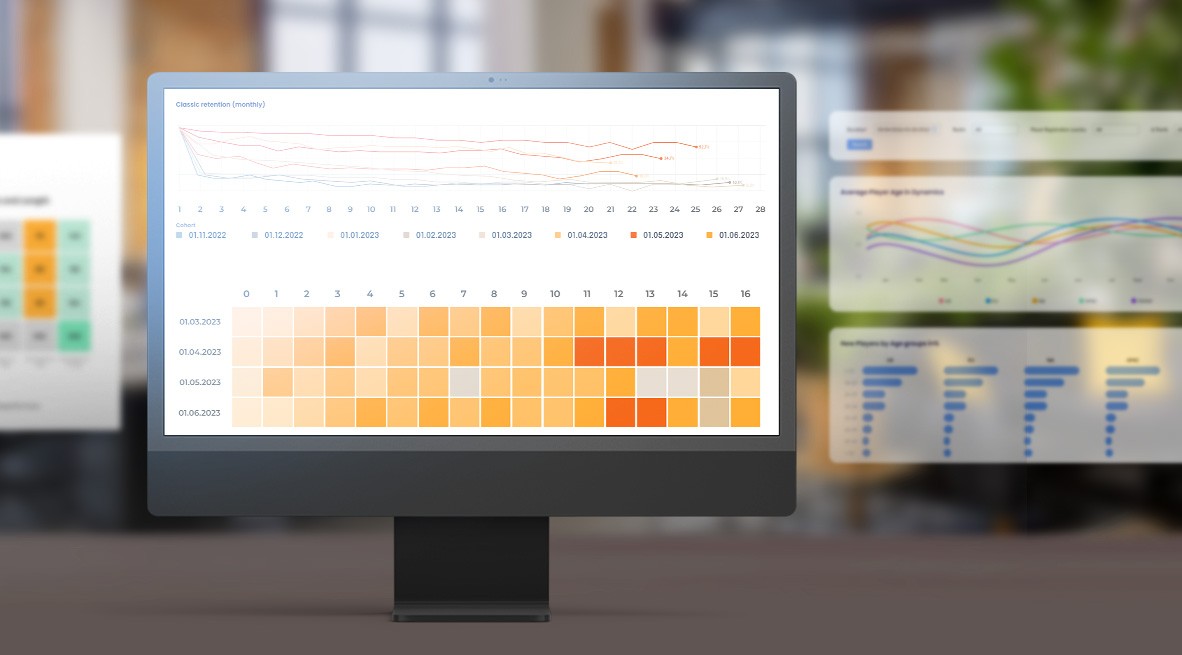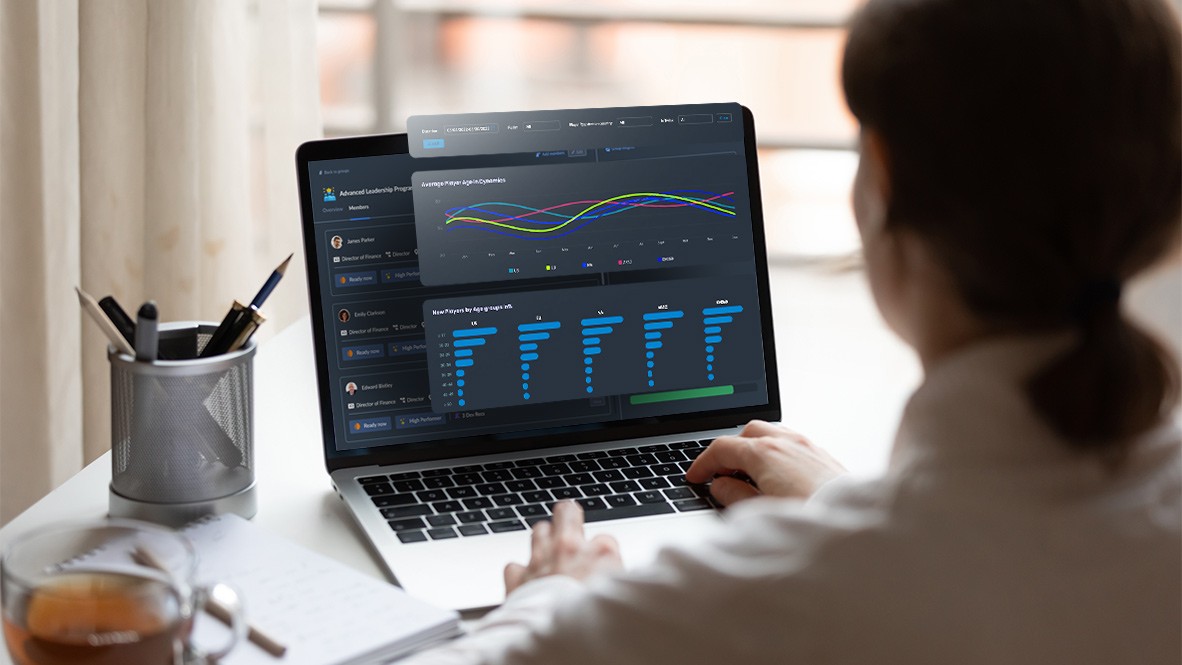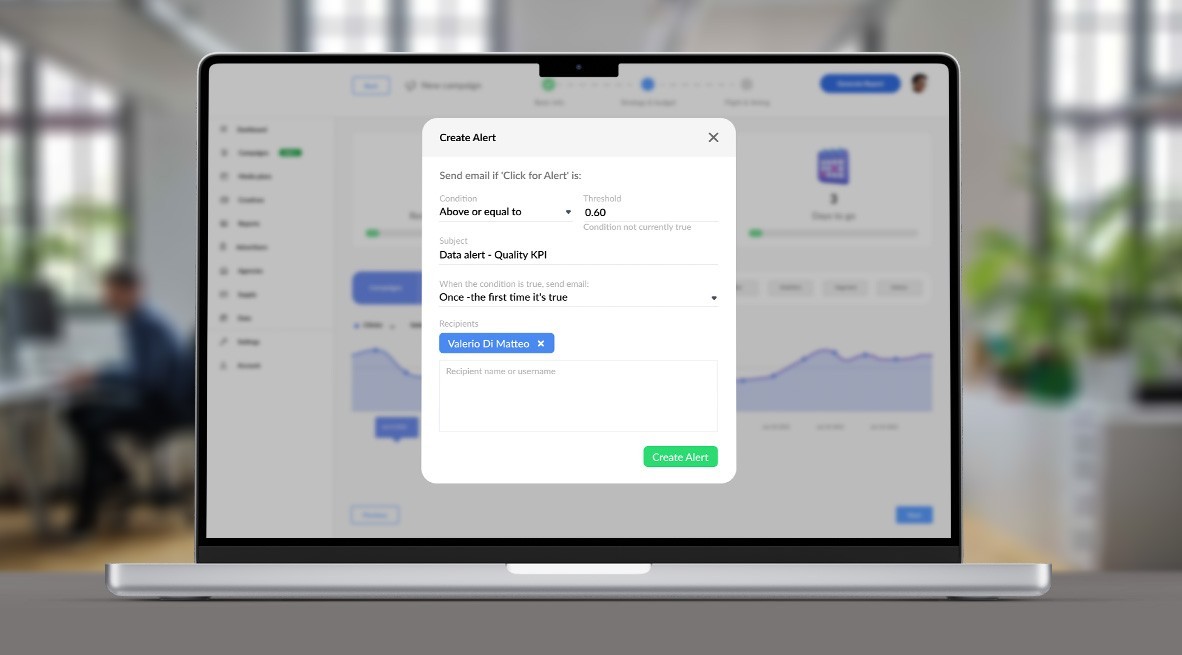Why is Big Data essential for eLearning platforms? We bet you know the answer
It’s no revelation that all EdTech companies (be it learning platforms like Coursera and Busuu, or course marketplaces like Udemy, Domestika, etc.) hardly set their growth directions relying simply on inner intuition. Every decision these companies make is (or should be) based on data-driven analysis of all educational process components.
And you’ve likely come across many clickbait materials eloquently enumerating the ways data is transforming education with improving performance efficiency, creating customizable learning programs, personalizing content for individual needs, and… we could go on forever.
But let’s not take away the bread from such articles on obvious Big Data benefits. You’re probably here for more precise and actionable ideas, like:
- Metrics that businesses in the Education domain really need, unlike chaotic calculation of every received number.
- Exact kinds and formats of data representations that bring most value for each particular metric.
- Steps to be taken to attract new customers and retain current ones based on data gained.
Oxagile’s expert will equip you with these and other crucial insights that ensure Big Data makes any EdTech platform perfectly do what it should — captivate an ever-growing number of students with 100% effective courses.
Meet our Big Data expert
Dzmitry Shmuryeu
Oxagile’s Lead BI Developer and Data Visualization Enthusiast with 11+ years of production experience in Business Analytics and a proven track record in the EdTech domain, including significant involvement in product development processes.
Types of data that EdTech companies crave on their dashboards
Since the performance and overall success of any eLearning product can be examined from diverse viewpoints, we’ll explore 3 distinct aspects that one needs to measure for a comprehensive picture of the way different elements within the platform impact its dynamics.
1. Cohort retention
What’s the goal?
This metric implies collecting data on the students enrolled in the course, with the purpose of understanding how effective and compelling training programs are to keep them engaged. As a result, you get a chance to fix any issues at the right stage to maintain current users’ interest at the desired level and to bring back the lost ones.
Key Performance Indicators
 Retention rate
Retention rate (classic and rolling retention)

The
number of subscriptions bought and renewals made
 Up For Renewals (UFR)
Up For Renewals (UFR) — i.e., how many people are likely to renew their subscription for the next period
 Churn rate
Churn rate — i.e., the number of cancellations and their average timing

Daily Active Users
(DAU), Monthly Active Users
(MAU), Weekly Active Users
(WAU)
The number of users who
started watching video

The number of users who
finished watching video
The number of users who
watched a certain percentage of the video

The number of
times each
video was watched on average
Expert advice:
“Retention Rate is found to be most effective when being calculated and interpreted both in terms of cohorts (e.g., registration dates) and periods.
To assess the effectiveness of product changes, other strategic actions, or to identify emerging trends, such metrics as DAU, MAU, WAU should better be displayed in dynamics.
For some metrics, it will be also useful to do the segmentation of users, which will allow the generation of analytics within each segment (e.g., active learners, those who migrate to a more budget subscription, etc.) and applying a specific and custom approach for each case.
So, if you determine a category of “off-track souls” — the users who have registered, bought a subscription, set auto-renewal, but do not use the products, do not log in or do not attend classes, you might want to rethink their involvement, offer them some custom proposals, send personalized reminders and notifications, include more interactive activities, or simply facilitate discussions.”

2. User paths
What’s the goal?
A detailed analysis of user behavior, starting from him seeing an enticing ad to becoming a paying customer (assuming that the course is fee-based), helps to evaluate the effectiveness of the whole process and understand the possible problems. They can range from technical glitches to UI/UX issues regarding non-obvious clickable elements. Additionally, there may be cases where the offer is simply not interesting for certain users, resulting in them clicking on an ad but not progressing further.
Key Performance Indicators
 Click-Through Rate (CTR)
Click-Through Rate (CTR)
The number of people who visit the site
daily/weekly/monthly Conversion Rate
Conversion Rate — i.e., the number of people who perform some target action, like going to the registration page/ registering / starting the free trial period/ buying a subscription

The
average amount of time users spend on specific pages

The
exact steps where most users
exit the website or app

Types of
subscriptions bought more often

Average Revenue Per User (
ARPU) and Average Revenue Per Paying Users (
ARPPU)

Lifetime Value (
LTV) — the revenue a customer brings a brand throughout the whole course of their relationship
Expert advice:
“The thing to consider here is the source of data (whether it’s a website or a mobile application), because each of them has a different funnel for tracking a user’s path. For example, the initial stage for mobile apps’ funnel involves tracking the number of people who visit the application page, the subsequent number of downloads, and then the funnel progresses similarly to the web, measuring metrics such as registrations, and so on.”
3. Feedback and ratings
What’s the goal?
While it’s unlikely to be news to you, we still feel like emphasizing that timely gathered and processed user feedback has all the chances of becoming the easiest way of creating an ultimately pleasant experience for everyone involved.
Key Performance Indicators
 Customer Satisfaction Index (CSI)
Customer Satisfaction Index (CSI) Completion rate (COR)
Completion rate (COR) — the percentage of users who successfully complete the course
 Net Promoter Score (NPS) or User Loyalty Index
Net Promoter Score (NPS) or User Loyalty Index — how likely users are to recommend the company, make another purchase, or try other services
 Customer Satisfaction Score (CSAT)
Customer Satisfaction Score (CSAT) — can be measured in general, but it’s more effective to track it in small steps of interaction
Expert advice:
“On top of these three types of metrics, there is an aspect that is also undoubtedly worth your attention — it’s Payment Success Rate (PSR). This metric focuses on the reliability and efficiency of payment systems, as well as the proportion of successfully completed payments in comparison with the total number of orders. Here we are specifically referring to technical aspects at the stage of processing the payments: the reliability of the eCommerce system, the percentage of orders that are completed successfully, the number and reasons of failures, the quantity of pending cases, and related issues.”
It’s important here not to confuse users who are unable to make payments due to issues outside your platform with users who experience difficulties with payments due to poor UX on your side. This way, by closely monitoring these two different, yet similar, processes you’ll be able to promptly address the issue, for example, by reaching out to the support team of the payment system.
Capturing meaningful insights from collected metrics
No matter how much in-depth data you obtain, the primary objective is to ensure its clarity and accessibility for analysis. And that’s where graphics and visual presentations of all patterns and correlations come to the forefront. A good dashboard lets even those who do not have specialized Big Data skills (like marketing or product operation teams) examine all the complex data sets from different angles in real time.
So, what does it take to create a comprehensive dashboard with all education metrics? Here are the key things to consider:
- Information about the current state of metrics on the dashboard is designed to continuously monitor and act in case of a sudden decline in metrics.
- It is best to constantly compare the actual values of the metrics with their target values and how close/far from the intended plan the company is.
- Target metrics values can be set manually based on past trends, observations, and product objectives, or they can be automatically generated based on complex models developed by a dedicated Data Science/Analytics team, which calculate future metric value predictions based on historical statistics and considering many other factors, such as current user behavior, user profiles, user segment affiliations, and others.
Expert advice:
“To fully leverage the available information, it’s vital for the dashboard to have a drill-down capability.
Let’s say you notice that the overall retention rate has dropped. In an ideal drill-down dashboard, you would be able to click on the specific month and see which products and services experienced a decline in retention. A competent and dedicated product team, responsible for that particular product, can then quickly identify the reasons influencing these results. For instance, if the retention rates have decreased for a specific subscription after a recent interface change, the team may decide to conduct a survey among product users to get feedback and better understand the situation.”
Do you need specific Big Data solutions to stay current with every subtle shift in users’ behavior?
Oxagile will meet any of the project deliverables.

Getting maximum value of visualized data: your next steps
To make any dashboard with complex data tell not only colorful, but meaningful stories, our expert transformed his experience working with learning platforms and coaching services into best practices and a set of optimal strategies.
- 24/7 dashboard monitoring by key stakeholders. “Key stakeholders periodically monitor top-level dashboards with core KPIs. If the dashboard is more detailed and supports drill-down functionality, such dashboards can also be used by special departments that directly implement targeted actions and initiate product changes (e.g., marketing, sales, PR, LiveOps, development and operations teams, etc.).”
- Timely alerts and notifications. “Automation and alerting are crucial when receiving scheduled email or messenger notifications with either a snapshot of the current dashboard or specific values of critical metrics. Alerts can also be configured for notifications in case a metric drops below a threshold value.”

- A detailed view on how to act right. “If business intelligence functionality allows you to investigate the causes and get a list of users who have abruptly left, this may require several dashboards with more detailed information on each. The dashboards can be interconnected, so any of your employees from different departments can see the whole picture and get all the necessary details to take further action.”
If your dashboards fall short for custom needs — ad hoc analysis is at your service
In an ideal scenario, you’d be able to quickly create an all-encompassing data analytics solution that presents high-level statistics, as well as user-level details. However, achieving such functionality requires a meticulously planned and optimized architecture. Besides, not every system can handle the vast amount of data. Therefore, to still have a chance of getting data-driven insights, it becomes crucial to conduct on-the-spot analysis.
Analysts take on the task of unloading the list of users based on certain conditions and supplement the data with additional details. For example, if you find that 50% of users left last month, the data analyst uploads a list of users who were previously active in the product but stopped using it. He also adds information about these users’ payments and activity in your other products, as well as the results of surveys conducted among them.
Once this data is obtained, these users can be tagged in the CRM system, which initiates personalized efforts to engage and retain them. The dashboard analyst can independently perform a descriptive or diagnostic analysis of the data, or simply provide a raw report.

Expert comment:
One of the most important and, let’s face it, pleasant things about Big Data analytics is that all the research findings can be used perfectly well not only to fix immediate issues, but also to shape the future of your business. Years from now? Why not!
For example, in one of the recent educational projects (a language learning platform) I was involved in, we introduced interactive New Year’s gamification elements. Some were very trivial with bursting balls with right translations and getting random discounts, and some were almost substantial educational quests with characters and storylines that enabled getting more significant benefits if successfully completed. And thanks to the fact that during that hot New Year’s campaign we have clearly monitored our every user’s action related to our innovation, the next year the marketing specialists had a thorough dashboard on hand that showed exactly which activities were received with enthusiasm by particular groups of users, which had all the rights to be considered mishaps, and what modifications could be made to game characters to ensure the highest conversion rate possible.
And voilà — the next year showed a nearly three-fold increase in profits over the Christmas period. And yes, the best part is still that this year such monitoring will take almost no effort, because all the processes are already set up.



























